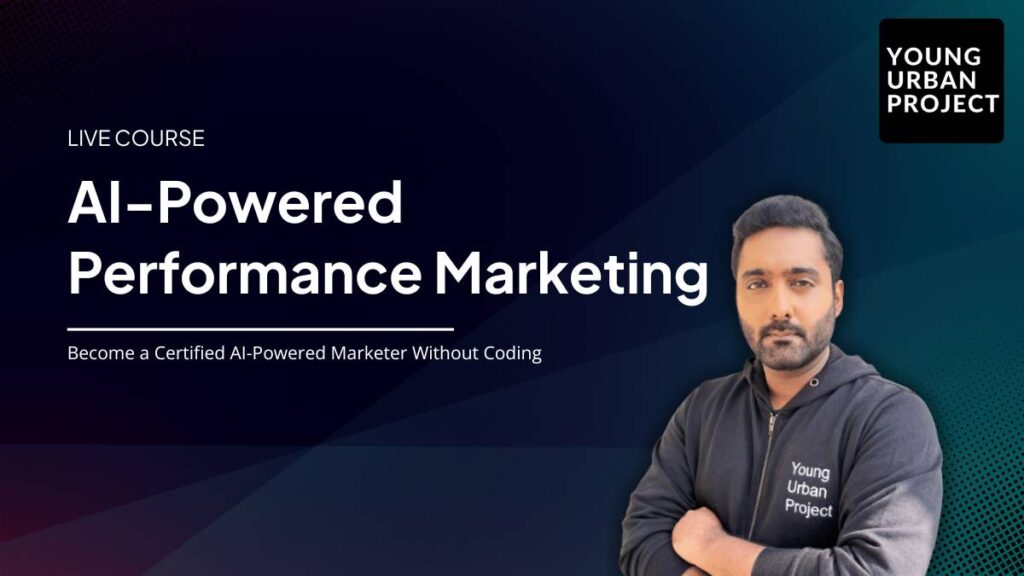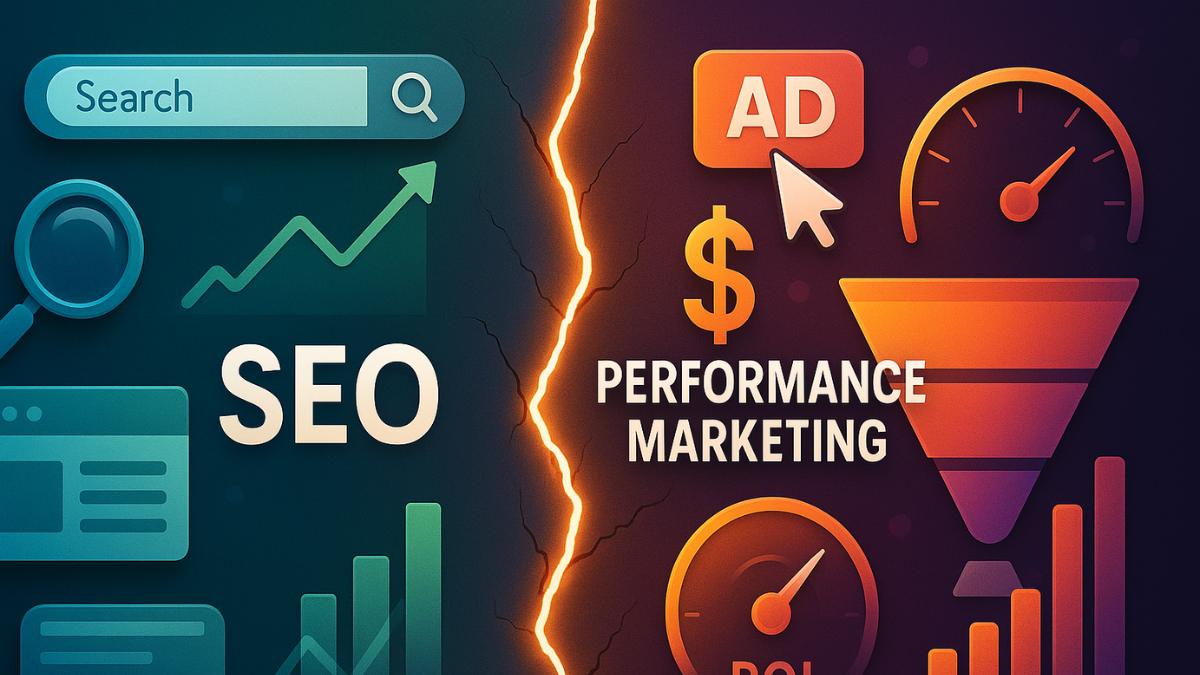If you’ve ever sat through a marketing meeting where someone said, “Let’s pause SEO and go all-in on performance marketing,” you’re not alone.
Table of Contents
This tug-of-war between SEO (Search Engine Optimization) and Performance Marketing happens all the time, especially in growing companies trying to decide where to put their money for the biggest returns.
Here’s the thing though: they’re not enemies. But they are very different beasts.
One builds long-term brand equity and organic discovery. The other drives instant visibility and measurable actions, clicks, signups, sales, sometimes within hours.
And yet, marketers often treat it like a “this or that” decision.
So, this blog is here to do three things:
- Clear up the confusion (without the jargon overload)
- Help you compare SEO vs performance marketing based on real business goals
- Show you how to use both strategies together, like a smart marketer should
Let’s start by breaking down what each really is.
What is SEO? (Search Engine Optimization)
SEO is the art and science of getting your content discovered organically (aka without paying for ads) on search engines like Google, Bing, and even YouTube.
At its core, SEO is about making your website and content more discoverable, relevant, and trustworthy in the eyes of search engines, so that you show up when your target audience is looking for what you offer.
There are three main types of SEO, and they all work together:
1. On-Page SEO
This is everything you control on your own site, like optimizing your blog titles, meta descriptions, URLs, headers, and keywords. It also includes improving readability, structuring content well, and ensuring you’re answering user intent.
2. Off-Page SEO
This involves building credibility through external signals like backlinks (when other websites link to yours), social mentions, and even online reviews. Think of it as “reputation management” for your site.
3. Technical SEO
The technical SEO part is a bit geekier, it’s about site speed, mobile-friendliness, structured data, crawling/indexing, and all the things that make your site easier for search engines to understand and rank.
The Long-Term Payoff of SEO
SEO isn’t a quick win. It’s more like a mutual fund, steady growth, compounding returns, and stronger brand equity over time.
You might not see major results in the first few months, but once you build momentum, SEO can drive free traffic, consistently, without paying for every click.
It’s also a trust-builder. Users tend to trust organic results more than ads, especially for research-heavy decisions.
Also Read: What are Zero-Click Searches in SEO
Real-World Example: HubSpot’s SEO Machine
Take HubSpot, for example. Their blog dominates search rankings for thousands of marketing, sales, and CRM-related keywords. Why?
Because they’ve spent years publishing high-quality, keyword-optimized content backed by strong internal linking and solid domain authority.
They don’t need to buy ads for “what is inbound marketing”; they own that space organically.
That’s the power of SEO when done right.
What is Performance Marketing?
Now let’s talk about the flashier sibling: Performance Marketing.
Performance marketing refers to any digital marketing activity where you pay only when a specific action is taken, a click, a lead, a sale, an app install, etc.
So instead of paying for exposure, you’re paying for results.
It’s immediate, trackable, and often driven by platforms that let you dial in your targeting like a sniper rifle.
Here are the most common platforms used for performance marketing:
- Google Ads (Search, Display, YouTube)
- Meta Ads (Facebook, Instagram)
- TikTok Ads
- Affiliate Marketing
- Native Ads (Taboola, Outbrain)
- Amazon Ads (especially for D2C brands)
Read More: Scope of Performance Marketing
It’s All About Measurable ROI
The biggest allure of performance marketing is control and speed.
You can test an idea, run a campaign, and get results within hours, sometimes minutes. You can track every click, cost, conversion, and tweak accordingly.
This makes it ideal for things like:
- Product launches
- Sales and discounts
- Lead generation
- Time-sensitive offers
- Scaling revenue predictably
Real-World Example: Mamaearth’s Growth with Ads
Consider Mamaearth, a well-known D2C beauty brand in India.
In their early days, they leaned heavily on Meta and Google Ads to reach their target audience, new moms, young women, and conscious shoppers.
Their aggressive paid strategy (combined with influencer marketing and UGC) allowed them to scale fast, acquire customers at a decent CAC (Cost per Acquisition), and optimize in real-time.
SEO came in later, but performance marketing built the engine.
Also Read: Performance Marketing and Digital Marketing
Difference Between SEO and Performance Marketing
Here’s a straight-up, no-fluff comparison between SEO and performance marketing. Think of this as your cheat sheet before making any budget decisions:
| Factor | SEO | Performance Marketing |
| Timeline to See Results | Slow build, usually 3 to 6 months before you see consistent traffic or leads. | Fast, you can get traffic and conversions the same day your ads go live. |
| Cost Model | Mostly time, effort, and tools. You’ll invest in writers, tools, maybe agencies. | Pay-per-click, lead, or sale, you pay each time someone acts. |
| ROI Measurability | ROI is slower and indirect, but it grows over time and compounds. | ROI is immediate and clear, every rupee spent can be tracked to results. |
| Sustainability | Long-lasting. Once ranked, content keeps driving traffic with little spend. | Stops instantly when you pause or run out of budget. |
| Trust Factor | Higher, users often trust organic listings more than sponsored ones. | Lower, ads can feel salesy or pushy, especially if overused. |
| Skill Requirement | Needs content strategy, keyword research, tech knowledge, and patience. | Requires media buying, targeting, copywriting, and data analysis. |

Enroll Now: AI-Powered Performance Marketing Course
When Should You Invest in SEO?
1. If you’re building a content-heavy brand
SEO shines when your marketing revolves around educational or evergreen content. Blogs, guides, videos, and infographics can bring compounding traffic over time, making it perfect for brands playing the long game in thought leadership and organic discoverability.
2. When organic growth is a long-term goal
If your brand wants to reduce reliance on ads in the future, investing in SEO today can help build a foundation of organic traffic. Over time, this reduces your cost per acquisition and gives you more predictable inbound visibility.
3. Ideal for industries like SaaS, blogs, and news
Businesses that rely on consistent search behavior, like software tools, publishers, and informational blogs, benefit hugely from SEO. Users are constantly searching for how-tos, comparisons, or updates, which makes SEO traffic highly relevant and recurring.
Note: Don’t expect instant magic
SEO doesn’t deliver overnight results. If you’re launching next week or need sales tomorrow, SEO won’t help in the short term. It’s a slow, iterative process that requires consistent effort, optimization, and patience, sometimes painfully so.
Also Read: How to Prepare a Performance Marketing Media Plan
When is Performance Marketing the Better Option?
1. Perfect for product launches, discounts, and limited-time campaigns
If you’re launching a new product or running a sale that ends Friday, performance marketing is your best friend. You can get visibility instantly, push urgency with ads, and control where and when your offer shows. It’s made for fast-paced moves.
2. Startups with funding or initial budgets can grow fast
When you’ve got some capital to spend and need traction quickly (hello, pitch deck pressure), ads let you test messaging, reach your niche audience, and generate real data, fast. It’s a faster route to product-market fit compared to waiting on SEO.
3. Be mindful of ad fatigue and rising CPCs
Here’s the flip side. The more people see the same ad, the less they click. That’s ad fatigue. Add to that rising CPCs (cost-per-click) on crowded platforms like Meta and Google, and you’ll burn through your budget faster than expected. Keep creative fresh and optimize daily.
Also Read: How Does Performance Marketing Work?
The Cost Factor: Budgeting for SEO vs Paid Marketing
1. SEO needs upfront effort, paid needs ongoing spend
SEO isn’t “free”, you’ll need to invest in writers, editors, tools like Ahrefs, and maybe a strategist or agency. But once content ranks, it keeps working. Paid marketing, meanwhile, requires constant spend. No spend = no visibility.
2. Costs go into tools, talent, and agency support
SEO demands keyword tools, content optimization platforms, maybe a tech SEO expert. Performance marketing needs media buyers, creative resources, and platform-specific know-how. Agencies might charge a retainer for SEO or a percentage of ad spend for paid campaigns.
3. How to optimize: balance short-term wins with long-term assets
A smart move? Allocate 60–70% of your budget to paid when you need quick results, but reinvest some into SEO monthly to build an organic moat. Over time, your dependency on ads reduces, and you get more efficient with spend.
Also Read: Growth Marketing vs Performance Marketing
Analytics & KPIs: Tracking What Matters
SEO metrics to watch
- Organic traffic (via GA4)
- Keyword rankings (via Ahrefs, SEMrush)
- Bounce rate and engagement time
- Backlink profile growth
- Pages per session
SEO is slower to measure, but over time, you’ll notice steady traffic growth and improved keyword visibility.
Performance marketing KPIs
- CTR (Click-Through Rate): Are people interested in your ad?
- CPA (Cost per Acquisition): What’s the cost of getting a customer?
- ROAS (Return on Ad Spend): Is the ad profitable?
- Impressions vs. conversions: Are you reaching the right people?
These Performance marketing metrics give fast, clear feedback. But you must track them constantly, performance shifts daily.
Tools that power both worlds
- GA4: Your single source of website truth
- Ahrefs / SEMrush: For tracking SEO rankings, links, and content gaps
- Meta Ads Manager / Google Ads: For running and optimizing campaigns
- Looker Studio: Great for blending SEO and ad data into visual dashboards
Also Read: Top Performance Marketing Tools
Hybrid Strategy: Can SEO and Performance Marketing Work Together?
Absolutely. In fact, most successful brands run both in tandem. It’s not a choice, it’s a balance.
1. Smart brands don’t pick one, they map both to the funnel
Use SEO to attract top-of-funnel (TOFU) awareness, like blogs, guides, and explainer content. Use performance marketing to close bottom-of-funnel (BOFU) traffic, like retargeting, lead magnets, and product ads. They complement each other beautifully.
2. Content can fuel both channels
That in-depth SEO blog you wrote? Slice it up into ad creatives for Meta. Or use SEO pages to warm up traffic that you later retarget with conversion ads. Great content should never live in just one channel, repurpose strategically.
3. Data sharing makes both smarter
Run a high-performing ad? Look at the copy and keywords, and use that intel to write a better blog. See a blog driving lots of organic traffic? Turn it into a landing page and run ads on it. The two sides should feed each other.
Also Read: Performance Marketing vs Brand Marketing
Common Myths Debunked
1. “SEO is free”
It’s not. You’re paying with time, effort, tools, and maybe agencies or freelancers. It may not cost per click, but it’s an investment nonetheless. And one that takes months to pay off.
2. “Ads are always expensive”
Only if you don’t optimize. With good targeting, creative, and testing, you can keep CAC low and scale profitably. Expensive ads usually signal a bad offer, poor targeting, or creative fatigue, not that the channel itself is broken.
3. “SEO is dead”
Nope. It’s evolving. Google’s algorithm changes and AI tools like ChatGPT are shifting how people search, but search is still happening. SEO is adapting, not dying.
4. “Paid is all you need”
Paid alone can drive traffic, sure. But without trust-building content, email follow-ups, or strong landing pages, you won’t convert well. You need the whole ecosystem, not just ads.
Future Trends: What to Expect in 2025 and Beyond
1. AI is reshaping SEO, but not replacing it
Tools like ChatGPT are helping write drafts, brainstorm keywords, and outline posts, but real SEO still needs human strategy, topical depth, and originality. Google’s Search Generative Experience (SGE) may reduce clicks to sites, but also creates new opportunities for visibility.
2. Performance marketing is getting smarter with automation
Smart Bidding, Advantage+ campaigns, and AI-powered targeting are making it easier to automate and scale paid ads. But with that comes less manual control, so you’ll need to guide these systems with the right creative and conversion setup.
3. Privacy laws are forcing both channels to adapt
With cookies phasing out and platforms prioritizing user privacy, both SEO and paid marketers need new approaches. First-party data (email lists, CRM) will become critical. Contextual targeting and quality content will matter more than ever.
How to Choose What’s Best for Your Brand
Let’s get practical for a second.
It’s easy to get excited by blog stats or ad dashboards, but when it comes to deciding between SEO and performance marketing, you need a framework that keeps emotions and ego out of it.
Here’s how to break it down:
1. Start with your goals
- Need quick traffic or sales? → Lean on performance marketing
- Want to reduce CAC long-term? → Invest in SEO
- Building authority or community? → Go SEO-heavy
- Launching a time-sensitive product? → Performance first, SEO later
2. Assess your timeline
If your business needs results this quarter, SEO likely won’t move the needle fast enough. But if you have a 6–12 month runway and want to build lasting visibility, SEO is gold.
3. Look at your budget realistically
Ads eat money every day. But SEO needs upfront time, content, and tools. Neither is “cheap”, they’re just different kinds of investments. Ask: can you sustain ad spend for 3–6 months without panic?
4. Use this mini decision matrix
| Situation | Go With |
| New launch with a time-sensitive goal | Performance marketing |
| Long-term brand building | SEO |
| Budget is tight but you have time | SEO |
| You need to test product-market fit | Performance marketing |
| You already rank well, but conversions are low | Add performance to support BOFU |
5. B2B vs B2C: Use the channel differently
In B2B, SEO is often better for building trust, think whitepapers, comparisons, deep-dive blogs. In B2C, performance marketing helps you scale fast, but SEO still helps with retention content and community growth.
Conclusion: It’s Not ‘Either-Or’, It’s Strategy First
In the end, choosing between SEO and performance marketing isn’t really about picking a winner, it’s about understanding what your brand truly needs at this stage of its journey. SEO offers long-term sustainability, trust, and organic growth that compounds over time. Performance marketing, on the other hand, gives you speed, control, and the ability to scale quickly when done right. They serve different purposes, and the smartest brands don’t treat them as either-or, they use them together strategically.
Maybe you start with ads to gain traction, then gradually build your SEO engine to reduce costs and build authority. Or maybe you’re already ranking well and now want to amplify that traffic through paid remarketing. The point is: let your goals, timeline, and budget drive the mix. Marketing isn’t about following trends, it’s about making smart, intentional moves that support growth.
FAQs: SEO vs Performance Marketing
1. Which is more cost-effective: SEO or performance marketing?
SEO is more cost-effective over time because once your content ranks, it brings in free traffic. Performance marketing is more expensive long-term since you’re always paying for visibility. But in the short term, ads can get results faster and more predictably.
2. How long does it take to see results from SEO vs paid ads?
SEO usually takes 3–6 months to see traction, and sometimes longer depending on your niche and competition. Paid ads can drive traffic and conversions within hours of launching, as long as your targeting and creative are strong.
3. Can a small business use both SEO and performance marketing?
Absolutely. Even on a tight budget, you can run small retargeting campaigns while gradually building SEO through blogs or local search optimization. You don’t need to go all-in on one, just start with what fits your capacity and goals.
4. Is SEO dead in the age of paid ads and AI?
Not at all. SEO is evolving, not dying. AI tools and new search features are changing how users find content, but organic visibility is still crucial, especially for informational, local, and niche queries that paid ads often miss.
5. What skills or tools are needed for each strategy?
For SEO, you’ll need keyword research, content writing, basic technical understanding, and tools like Ahrefs, SEMrush, or Google Search Console. For performance marketing, skills like ad copywriting, targeting, analytics, and A/B testing are key, plus platforms like Meta Ads or Google Ads.
6. How do you measure ROI for SEO vs performance campaigns?
For SEO, look at traffic growth, keyword rankings, and how organic leads convert. ROI may take longer, but grows over time. For performance, track direct metrics like CPA, ROAS, and lead quality, your ROI is faster but depends on ongoing spend and optimization.

